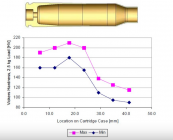I'm interested in building one of these units as well. I've developed heating sequences for industrial induction processes, so I'm familiar with the concept, but I've never built one. I'm reading through all 183 pages of information now, and I hope you guys who are currently building units keep posting so I can follow your progress.
This may have been answered already, but is there a good way to verify the inductance of our handmade coils?
FYI, closed-loop feedback has been mentioned a few times, and in my experience, it hasn't worked well for this kind of application. Pyrometers (IR sensors) rely on an emissivity value to estimate temperature, and emissivity often changes as a part is heated. Additionally, metals often reflect IR as a mirror, and sources of heat from the station itself (such as the coil) will contribute to bad readings. IR sensors generally have a conical field of view, so they need to be placed carefully to minimize error. Whenever their values are suspect, they need to be checked against a handheld thermocouple. A PID controller is only effective when the feedback is accurate. For this application, constant power for a fixed time is almost certainly the best option, as long as power is in fact constant, and the timer is consistent. This assumes the brass will always start close to room temperature and will be clean and dry, of course. I've no doubt that some clever builders can get a PID running well, but the investment in time and money is probably not worth it for most of us.
This may have been answered already, but is there a good way to verify the inductance of our handmade coils?
FYI, closed-loop feedback has been mentioned a few times, and in my experience, it hasn't worked well for this kind of application. Pyrometers (IR sensors) rely on an emissivity value to estimate temperature, and emissivity often changes as a part is heated. Additionally, metals often reflect IR as a mirror, and sources of heat from the station itself (such as the coil) will contribute to bad readings. IR sensors generally have a conical field of view, so they need to be placed carefully to minimize error. Whenever their values are suspect, they need to be checked against a handheld thermocouple. A PID controller is only effective when the feedback is accurate. For this application, constant power for a fixed time is almost certainly the best option, as long as power is in fact constant, and the timer is consistent. This assumes the brass will always start close to room temperature and will be clean and dry, of course. I've no doubt that some clever builders can get a PID running well, but the investment in time and money is probably not worth it for most of us.













